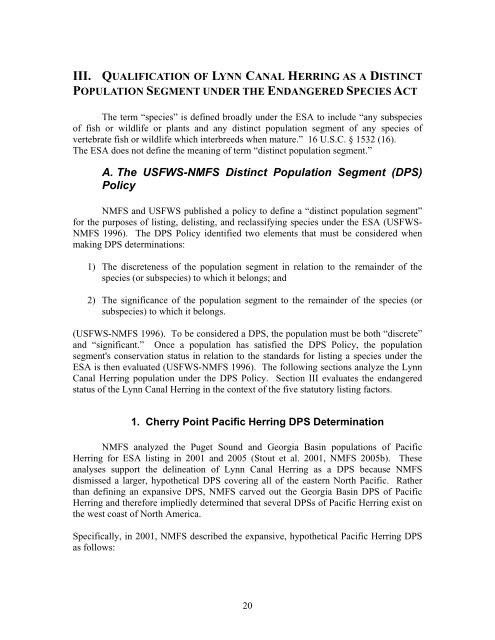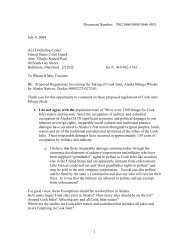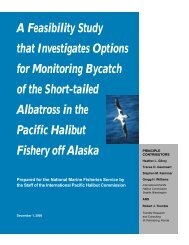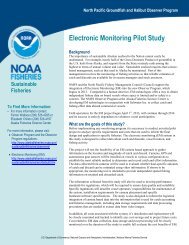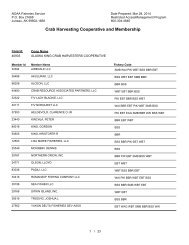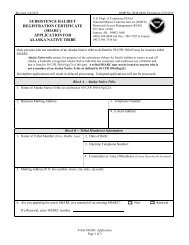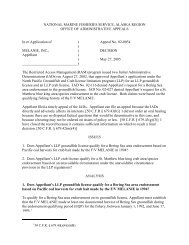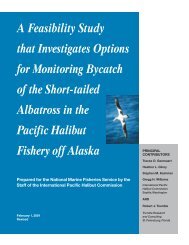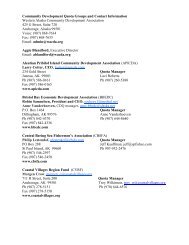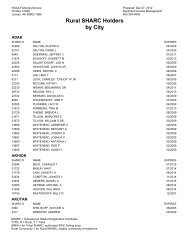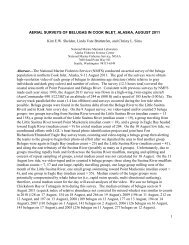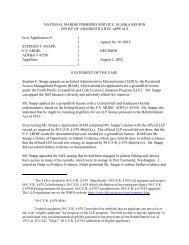Petition to List Lynn Canal Pacific Herring under the Endangered ...
Petition to List Lynn Canal Pacific Herring under the Endangered ...
Petition to List Lynn Canal Pacific Herring under the Endangered ...
You also want an ePaper? Increase the reach of your titles
YUMPU automatically turns print PDFs into web optimized ePapers that Google loves.
III. QUALIFICATION OF LYNN CANAL HERRING AS A DISTINCT<br />
POPULATION SEGMENT UNDER THE ENDANGERED SPECIES ACT<br />
The term “species” is defined broadly <strong>under</strong> <strong>the</strong> ESA <strong>to</strong> include “any subspecies<br />
of fish or wildlife or plants and any distinct population segment of any species of<br />
vertebrate fish or wildlife which interbreeds when mature.” 16 U.S.C. § 1532 (16).<br />
The ESA does not define <strong>the</strong> meaning of term “distinct population segment.”<br />
A. The USFWS-NMFS Distinct Population Segment (DPS)<br />
Policy<br />
NMFS and USFWS published a policy <strong>to</strong> define a “distinct population segment”<br />
for <strong>the</strong> purposes of listing, delisting, and reclassifying species <strong>under</strong> <strong>the</strong> ESA (USFWS-<br />
NMFS 1996). The DPS Policy identified two elements that must be considered when<br />
making DPS determinations:<br />
1) The discreteness of <strong>the</strong> population segment in relation <strong>to</strong> <strong>the</strong> remainder of <strong>the</strong><br />
species (or subspecies) <strong>to</strong> which it belongs; and<br />
2) The significance of <strong>the</strong> population segment <strong>to</strong> <strong>the</strong> remainder of <strong>the</strong> species (or<br />
subspecies) <strong>to</strong> which it belongs.<br />
(USFWS-NMFS 1996). To be considered a DPS, <strong>the</strong> population must be both “discrete”<br />
and “significant.” Once a population has satisfied <strong>the</strong> DPS Policy, <strong>the</strong> population<br />
segment's conservation status in relation <strong>to</strong> <strong>the</strong> standards for listing a species <strong>under</strong> <strong>the</strong><br />
ESA is <strong>the</strong>n evaluated (USFWS-NMFS 1996). The following sections analyze <strong>the</strong> <strong>Lynn</strong><br />
<strong>Canal</strong> <strong>Herring</strong> population <strong>under</strong> <strong>the</strong> DPS Policy. Section III evaluates <strong>the</strong> endangered<br />
status of <strong>the</strong> <strong>Lynn</strong> <strong>Canal</strong> <strong>Herring</strong> in <strong>the</strong> context of <strong>the</strong> five statu<strong>to</strong>ry listing fac<strong>to</strong>rs.<br />
1. Cherry Point <strong>Pacific</strong> <strong>Herring</strong> DPS Determination<br />
NMFS analyzed <strong>the</strong> Puget Sound and Georgia Basin populations of <strong>Pacific</strong><br />
<strong>Herring</strong> for ESA listing in 2001 and 2005 (S<strong>to</strong>ut et al. 2001, NMFS 2005b). These<br />
analyses support <strong>the</strong> delineation of <strong>Lynn</strong> <strong>Canal</strong> <strong>Herring</strong> as a DPS because NMFS<br />
dismissed a larger, hypo<strong>the</strong>tical DPS covering all of <strong>the</strong> eastern North <strong>Pacific</strong>. Ra<strong>the</strong>r<br />
than defining an expansive DPS, NMFS carved out <strong>the</strong> Georgia Basin DPS of <strong>Pacific</strong><br />
<strong>Herring</strong> and <strong>the</strong>refore impliedly determined that several DPSs of <strong>Pacific</strong> <strong>Herring</strong> exist on<br />
<strong>the</strong> west coast of North America.<br />
Specifically, in 2001, NMFS described <strong>the</strong> expansive, hypo<strong>the</strong>tical <strong>Pacific</strong> <strong>Herring</strong> DPS<br />
as follows:<br />
20


